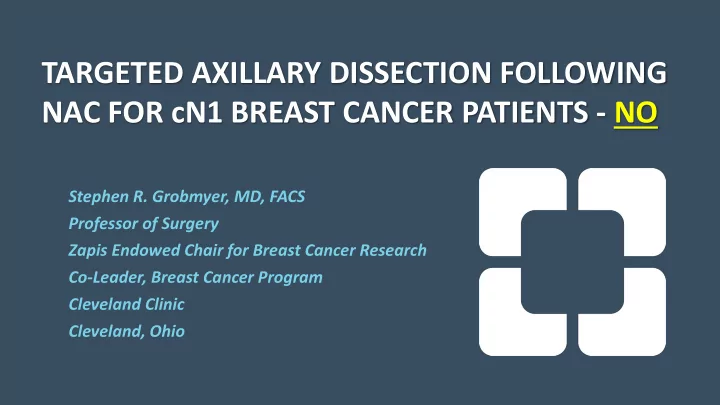

TARGETED AXILLARY DISSECTION FOLLOWING NAC FOR cN1 BREAST CANCER PATIENTS - NO Stephen R. Grobmyer, MD, FACS Professor of Surgery Zapis Endowed Chair for Breast Cancer Research Co-Leader, Breast Cancer Program Cleveland Clinic Cleveland, Ohio
Disclosures • Travel support - Zeiss Meditech • Medical Advisory Board - Seno Medical • Research Support - Mitaka USA • Research Support - GRAIL • Research Support - Lumicell
Early Trial Results Suggest There May Be Role of SLN Biopsy/Targeted Dissection
We Should Not Be Doing Targeted Dissection or SLN After NAC • We should be doing axillary dissection • Axillary lymph node dissection (ALND) has been a standard for years • ALND is associated with excellent long term control • SLN mapping fails in 7-13% of patients following NAC • Does not require use of potentially toxic blue dyes
Patients Determined to Be ycN0 Following ALND Derive Little Benefit from Radiation Therapy • 30 patients from MDACC with stage II breast cancer treated with ALND following NAC • 10 year LRR recurrence rate - With adjuvant radiation (n=10) = 0% - Without adjuvant radiation (n=20) = 0% • With complete axillary nodal staging we can truly declare a patient ypN0! McGuire et al. Int J Radiation Biol Phys 68(4): 1004, 2007.
Complete ALND Provides Accurate Nodal Staging Information with is Prognostic Residual metastatic LN 3 Year DFS p Value • 0 78% 0.05 • 1-3 80% • 4-10 50% • >10 44% Accurate nodal staging is not possible without ALND as sentinel node biopsy or targeted axillary dissection is associated with false negative rate 7-31%. This type of powerful staging information could be useful for stratifying patients into extended adjuvant therapy trials . Kuerer et al. Am J. Surg . 176: 502, 1998.
We Don’t Need to Abandon ALND; We Need to Do the Operation Better • Axillary Reverse Mapping has been shown to be associated with very low rates of lymphedema Axillary Reverse Mapping • LV bypass can also be utilized to minimize lymphedema rates LV Bypass Tummel, Klimberg et al. Ann Surg 265(5): 987, 2017. Shilad, Cakmakoglu, Schwarz, Valente, Djohan, Grobmyer. ASO 25(1): 3106, 2018.
If One Chooses to Perform SLN Biopsy After NAC for cN1 Patients: • Addition of targeted node removal adds little oncologic value • Addition of targeted node adds cost, complications, and patient discomfort unnecessarily
TARGETED AXILLARY DISSECTION • Place clip or seed in node biopsied before NAC • Remove targeted node + SLN biopsy
Newer Studies Suggest that SLN Biopsy Following NAC is Feasible With use of dual tracer SLN mapping, FNR of SLN biopsy and clipped node is very similar; clinically insignificantly different.
SLN Biopsy Without Node Targeting is Safe and Effective • 71 SLN (-) patients following NAC - 87% had > 3 SLNs - 13% had < 3 SLNs • SLN mapping with dual tracer and retrieving 3 nodes results in similar FNR to targeted node dissection • Performance of targeting procedures becomes superfluous. Mamtani et al. Ann Surg Onc 23: 3467, 2016.
Long Term Results with Targeted Axillary Dissection are Sparse • Little long term recurrence data from prospective trials of SLN biopsy in cN1 patients is available • Possible that residual chemo resistant cells left behind have negative impact on recurrence
Most Patients cN1 Patients Having NAC Receive Adjuvant Radiation Therapy • NCCN guidelines: “Strongly consider” RT for cN1, ypN0 patients • Practice pattern studies suggest most cN1, yPN0 patients receive post-mastectomy RT • Uncertainty of residual disease in non- sentinel nodes likely contributes to this decision in patients having NCCN guidelines V4.2018 De B. Lima, et al. Rep Pract Oncol and Radio 24: 115, 2019.
Many Technical Challenges with Targeted Axillary Dissection Things Not Discussed in Papers • Additional invasive axillary procedures - Risk of hematoma - Patient discomfort • Increased cost (seeds, procedures, localizing devices) • What do with lost clip at time of surgery? • What do if clip migrates from node which has been treated? • Multiple positive nodes-which one should be clipped?
If You Considering Targeted Axillary Dissection • Axillary dissection +/- ARM and LVB can give best staging and local control with minimal side effects • SLN with dual dyes and removal of > 2 nodes yields good results without limitations of targeted axillary dissection
Recommend
More recommend